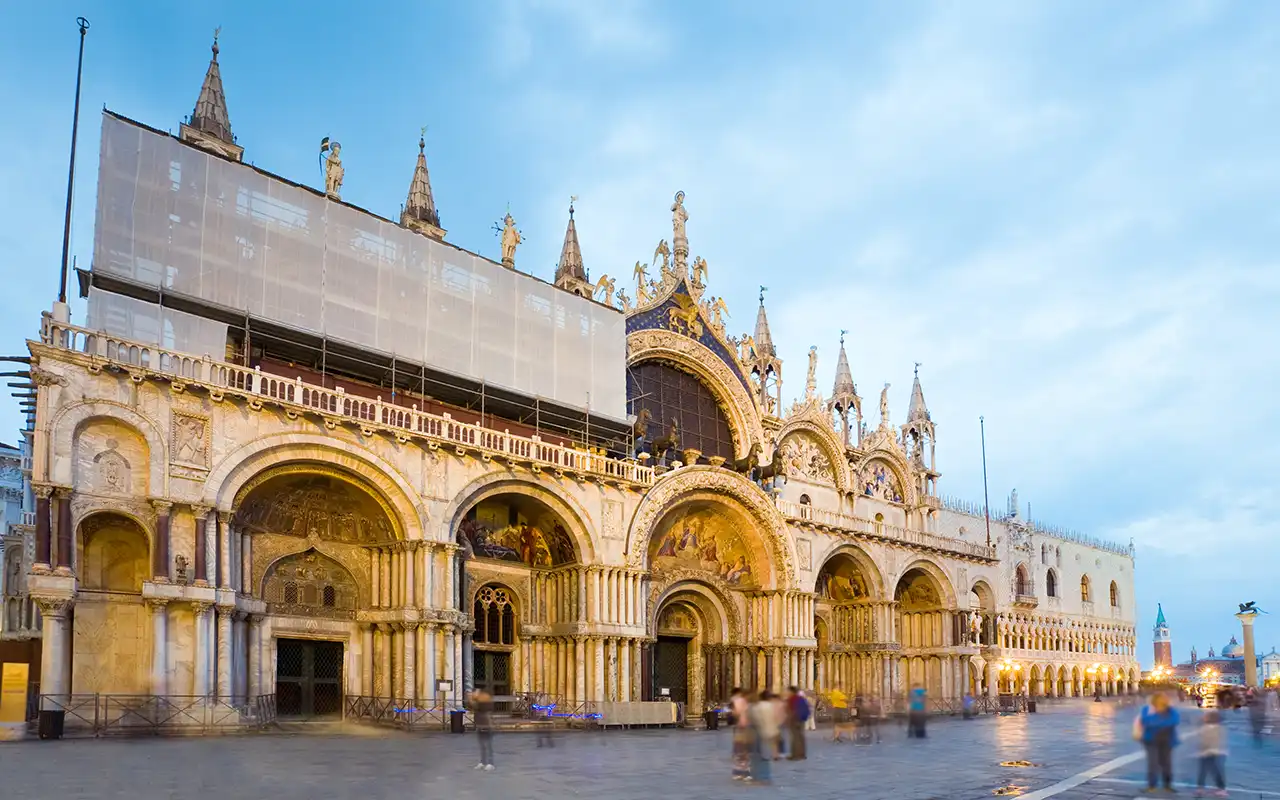
Navigating St. Mark's Basilica : Answers to common questions
- Washrooms: Accessible washroom facilities are available within or near the basilica.
- Hours of Operation: The basilica's opening hours can vary, typically from morning until late afternoon. Visitors are advised to check the current schedule before their visit.
- Important Information: St. Mark's Basilica, a masterpiece of Byzantine art, is one of Venice's most famous landmarks, known for its opulent design, golden mosaics, and its status as a symbol of Venetian wealth and power.
- Admission Fee: Entrance to St. Mark's Basilica is free, but there may be charges for access to certain areas or for guided tours.
- How Long to Visit: The duration of a visit can vary, with a typical visit lasting around an hour, longer if participating in a guided tour or attending a service.
- Parking: Limited parking is available in the vicinity of St. Mark's Basilica, with better options found on the mainland. Public water transport is the most common way to reach the basilica.
- Family Friendly: St. Mark's Basilica is family-friendly, welcoming visitors of all ages to explore its architectural and historical grandeur.
- Photography: Photography is restricted inside St. Mark's Basilica to preserve the sanctity and artistic integrity of the space.
- WIFI: Public WIFI is not typically available within the basilica.
- Picnic Area: No picnic areas are available within the basilica. However, the adjacent St. Mark's Square provides a scenic setting for outdoor eating, respecting the local regulations.
- Handicap Accessible: The basilica is accessible to visitors with disabilities, offering ramps and special entrance ways to accommodate all guests.
- Pets: Pets are not allowed inside St. Mark's Basilica, with an exception for service animals.
- Guided Tours: Guided tours are available, providing in-depth insights into the basilica's history, architecture, and its significant religious artifacts.
- Restaurant or Cafe: There are no dining facilities within St. Mark's Basilica, but the surrounding area offers a wide variety of restaurants and cafes.
- Gift Shop: The basilica has a gift shop offering religious artifacts, books, and souvenirs related to the basilica and its history.
Please note all times and prices subject to change. Please check the offical website for details.
In about 1063, a group of Venetian statesmen and religious leaders decided to build a cathedral on the existing grounds of an even older church, the plan being to house and honour the remains of the saint, Mark the Evangelist; the original building became the crypt of the new, magnificent basilica. Erected over a number of years (the gold mosaic floor alone took centuries), by a range of local craftsmen, the cathedral is attached to the adjacent Doge’s Palace and was originally its chapel.
More in our list of Things To Do In Venice
;Venice Current Weather
Local Temp: 14.5℃ / 58.1℉
High: 15.7℃ / 60.3℉
Low: 13.4℃ / 56.1℉
Humidity: 95 %
Local Time: 09:11
Map for St. Mark's Basilica
Did You Know?
An architectural masterpiece, St. Mark's Basilica blends elements of Byzantine, Romanesque, and Gothic architecture, reflecting the diverse influences that have shaped Venice's history. The basilica's iconic façade features five domes and a series of arches adorned with statues, mosaics, and marble columns, showcasing the wealth and artistic heritage of the Venetian Republic.
The Pala d'Oro, an exquisite altarpiece located inside the basilica, is one of the most valuable and important examples of Byzantine enamel work. Composed of gold, silver, and hundreds of gemstones, the Pala d'Oro is a stunning testament to the craftsmanship of medieval artisans and the basilica's long-standing connection to Byzantine culture.
St. Mark's Basilica, located in Venice, Italy, is one of the most famous and visually stunning cathedrals in the world. Originally built in the 9th century to house the relics of St. Mark the Evangelist, which were smuggled out of Alexandria, Egypt, the basilica has been rebuilt and expanded several times over the centuries, resulting in its current magnificent form.
The basilica's famous bronze horses, known as the Horses of Saint Mark, are replicas of ancient statues that were looted from Constantinople during the Fourth Crusade in 1204. Originally placed on the façade of the basilica, the horses were moved indoors to protect them from damage, and the replicas now stand in their place outside, overlooking the Piazza San Marco.
The basilica is renowned for its opulent design and extensive use of golden mosaics, which cover an area of about 8,000 square meters. These mosaics depict scenes from the Bible and the life of St. Mark, illuminating the interior with a heavenly glow that has earned the basilica the nickname "Chiesa d'Oro" or "Church of Gold."
Travel Information for
Venice Visitors
Time Zone: Venice operates on Central European Time (CET), which is 1 hour ahead of Greenwich Mean Time (GMT+1).
Weather: Venice has a humid subtropical climate. Summers are warm and humid with average temperatures around 27°C (81°F), while winters are cold with temperatures averaging around 3°C (37°F). Acqua alta (high water) is a phenomenon that causes flooding in Venice, typically occurring in autumn and winter.
Population: Venice has a population of about 260,000 residents. However, this number is steadily decreasing due to various factors, including rising living costs and flooding issues.
Size: The city covers an area of about 414.6 square kilometers (160.1 square miles), including both the lagoon and the historical city.
Language: Italian is the official language. Venetian, a distinct dialect of Italian, is also widely spoken. English is commonly used in tourist areas.
Currency: Italy uses the Euro (€). Credit cards are widely accepted, but it’s always useful to have cash for smaller shops and restaurants.
Safety: Venice is generally safe for tourists. However, like in any major tourist destination, it's wise to be cautious of pickpockets and scams targeting tourists.
Tipping: Tipping in Venice is not obligatory, but it's appreciated. In restaurants, it’s customary to leave a small tip (around 5-10%) if the service is good.
Electricity and Plugs: Italy uses Type C, F, and L plugs, and the standard voltage is 230 V with a standard frequency of 50 Hz. Travelers from countries with different standards will need adapters.
Water: Tap water in Venice is safe to drink. In fact, it's known for being high quality.
Verified & Trusted Contact Information for St. Mark's Basilica
Address:
Piazza San Marco
Website: www.basilicasanmarco.it/en/basilica
Latitude: 45.4346
Longitude: 12.3398
More Places and Things To Do in Venice Within 500 km/300 mi of St. Mark's Basilica
The Peggy Guggenheim Collection

The Distance from St. Mark's Basilica to The Peggy Guggenheim Collection is 0.8 KM / 0.5 MI
The Dorsoduro neighborhood

The Distance from St. Mark's Basilica to The Dorsoduro neighborhood is 1.1 KM / 0.7 MI











